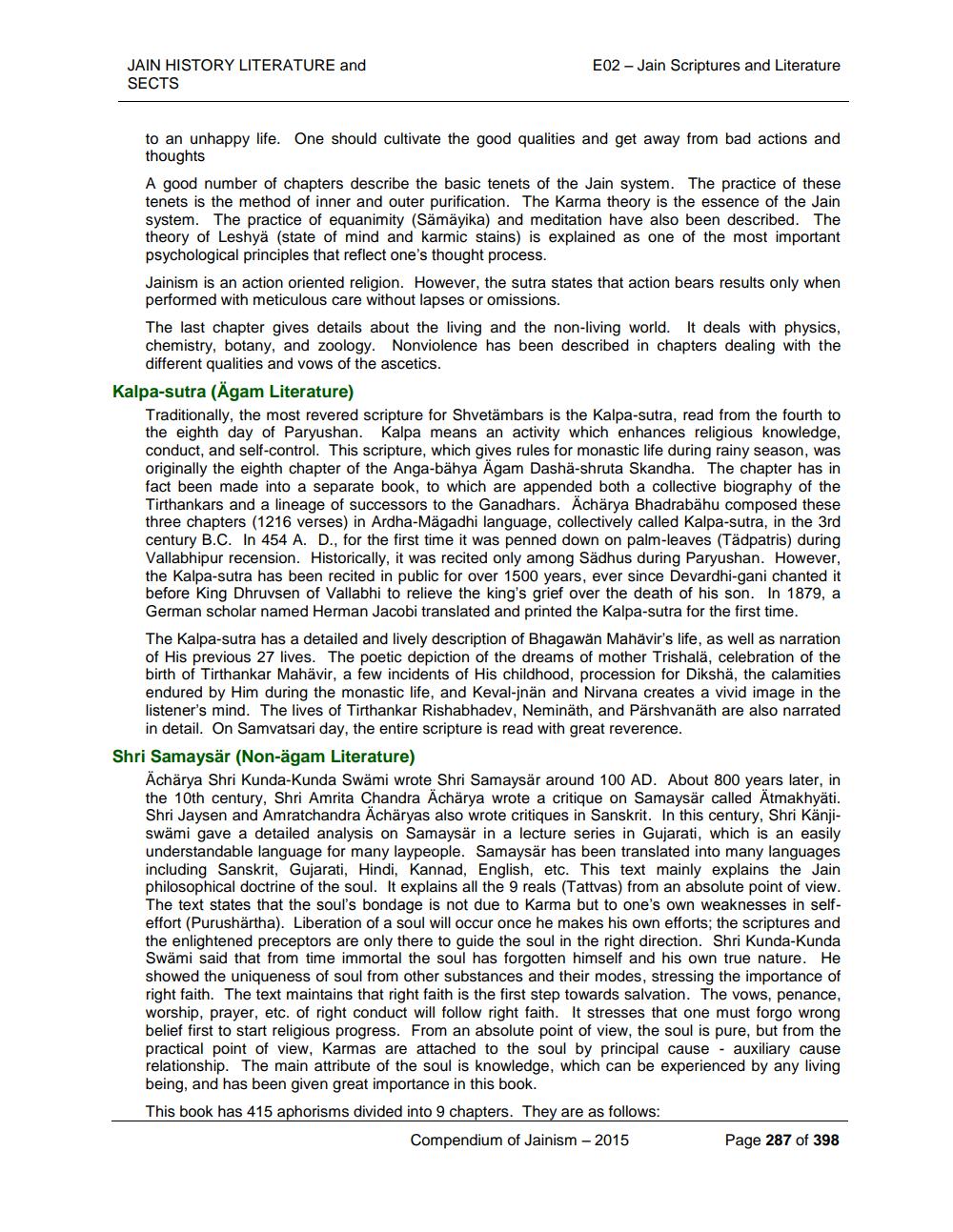________________
JAIN HISTORY LITERATURE and
SECTS
E02 Jain Scriptures and Literature
to an unhappy life. One should cultivate the good qualities and get away from bad actions and thoughts
A good number of chapters describe the basic tenets of the Jain system. The practice of these tenets is the method of inner and outer purification. The Karma theory is the essence of the Jain system. The practice of equanimity (Sämäyika) and meditation have also been described. The theory of Leshyä (state of mind and karmic stains) is explained as one of the most important psychological principles that reflect one's thought process.
Jainism is an action oriented religion. However, the sutra states that action bears results only when performed with meticulous care without lapses or omissions.
The last chapter gives details about the living and the non-living world. It deals with physics, chemistry, botany, and zoology. Nonviolence has been described in chapters dealing with the different qualities and vows of the ascetics.
Kalpa-sutra (Agam Literature)
Traditionally, the most revered scripture for Shvetämbars is the Kalpa-sutra, read from the fourth to the eighth day of Paryushan. Kalpa means an activity which enhances religious knowledge, conduct, and self-control. This scripture, which gives rules for monastic life during rainy season, was originally the eighth chapter of the Anga-bähya Ägam Dashä-shruta Skandha. The chapter has in fact been made into a separate book, to which are appended both a collective biography of the Tirthankars and a lineage of successors to the Ganadhars. Ächärya Bhadrabähu composed these three chapters (1216 verses) in Ardha-Mägadhi language, collectively called Kalpa-sutra, in the 3rd century B.C. In 454 A. D., for the first time it was penned down on palm-leaves (Tädpatris) during Vallabhipur recension. Historically, it was recited only among Sädhus during Paryushan. However, the Kalpa-sutra has been recited in public for over 1500 years, ever since Devardhi-gani chanted it before King Dhruvsen of Vallabhi to relieve the king's grief over the death of his son. In 1879, a German scholar named Herman Jacobi translated and printed the Kalpa-sutra for the first time.
The Kalpa-sutra has a detailed and lively description of Bhagawan Mahavir's life, as well as narration of His previous 27 lives. The poetic depiction of the dreams of mother Trishalä, celebration of the birth of Tirthankar Mahävir, a few incidents of His childhood, procession for Dikshä, the calamities endured by Him during the monastic life, and Keval-jnän and Nirvana creates a vivid image in the listener's mind. The lives of Tirthankar Rishabhadev, Neminäth, and Pärshvanäth are also narrated in detail. On Samvatsari day, the entire scripture is read with great reverence.
Shri Samaysär (Non-ägam Literature)
Ächärya Shri Kunda-Kunda Swämi wrote Shri Samaysär around 100 AD. About 800 years later, in the 10th century, Shri Amrita Chandra Ächärya wrote a critique on Samaysär called Ätmakhyäti. Shri Jaysen and Amratchandra Ächäryas also wrote critiques in Sanskrit. In this century, Shri Känjiswämi gave a detailed analysis on Samaysär in a lecture series in Gujarati, which is an easily understandable language for many laypeople. Samaysär has been translated into many languages including Sanskrit, Gujarati, Hindi, Kannad, English, etc. This text mainly explains the Jain philosophical doctrine of the soul. It explains all the 9 reals (Tattvas) from an absolute point of view. The text states that the soul's bondage is not due to Karma but to one's own weaknesses in selfeffort (Purushärtha). Liberation of a soul will occur once he makes his own efforts; the scriptures and the enlightened preceptors are only there to guide the soul in the right direction. Shri Kunda-Kunda Swämi said that from time immortal the soul has forgotten himself and his own true nature. He showed the uniqueness of soul from other substances and their modes, stressing the importance of right faith. The text maintains that right faith is the first step towards salvation. The vows, penance, worship, prayer, etc. of right conduct will follow right faith. It stresses that one must forgo wrong belief first to start religious progress. From an absolute point of view, the soul is pure, but from the practical point of view, Karmas are attached to the soul by principal cause auxiliary cause relationship. The main attribute of the soul is knowledge, which can be experienced by any living being, and has been given great importance in this book.
This book has 415 aphorisms divided into 9 chapters. They are as follows:
Compendium of Jainism - 2015
Page 287 of 398




